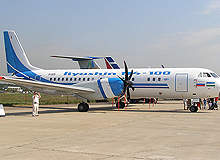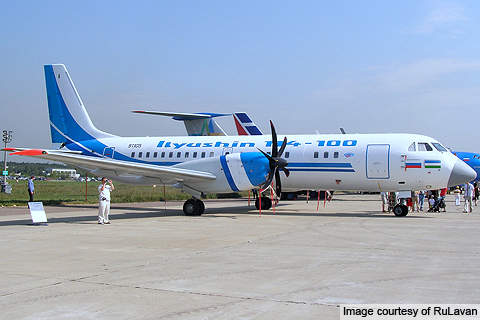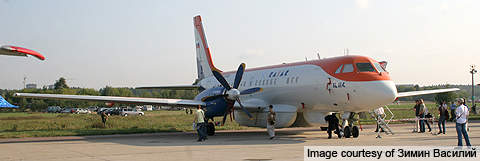The IL-114 is a mid-range passenger jetliner designed and manufactured by Ilyushin Aviation Complex (IAC) of Russia. It was built to supersede the aging fleet of IL-14 and An-24 airliners deployed within Russia. 14 IL-114s are currently operational worldwide.
The aircraft can execute passenger and cargo transportation, ecological studies, fish searches, ice reconnaissance and cartographic missions.
IL-114 variants
The IL-114 has ten variants: IL-114-100, IL-114-120, IL-114T, IL-114P, IL-114MP, IL-114FK, IL-114PR, IL-140, IL-140M and IL-114-300.
The IL-114-100 is an advanced version of IL-114, powered by two Pratt & Whitney Canada PW127 turboprop engines.
The IL-114-120 is powered by two PW-127H turboprop engines.
The IL-114T is a freight transport model built for Uzbekistan Airways. It is fitted with a 3.31m long and 1.78m wide cargo door at the rear fuselage and a removable roller floor.
The IL-114M is a maritime patrol version fitted with TV7M117 turboprop engines.
IL-114T is a freight transport model built for Uzbekistan Airways.”
The IL-114FK is a military reconnaissance aircraft built to carry out electronic intelligence (ELINT), reconnaissance and cartographic missions.
The IL-114PR is a defence version built to carry out signal intelligence (SIGINT) and airborne early warning (AEW) operations. IL-140M is a naval variant built to accomplish ecological monitoring, maritime patrolling and search and rescue missions.
The IL-114-300 is an improved version which increases fuel efficiency and minimises noise levels.
Orders and deliveries
Vyborg Airlines procured two IL-114 aircraft from IAC at the MAKS Airshow held in 2005.
Venezuela signed an agreement with IAC during the 2007 MAKS Airshow to procure 98 IL-114s, but the deal was cancelled.
Uzbekistan Airways acquired five IL-114s as of July 2010.
Design
The IL-114 is based on a free lift monoplane design. The aircraft is made up of advance composite metal alloys, including titanium, to reduce its overall weight. It was designed to take-off and land from unpaved airfields or short runways even in bad climatic conditions.
The basic design of the IL-114 was finalised in 1986.
Development, prototypes and maiden flights
The development of IL-114 began in 1980s. The maiden flight of the aircraft took place in March 1990. Production commenced in 1992. Four prototypes were built with an aim to achieve certification in 1993. The test programme was however delayed when one of the prototypes undergoing flight trails crashed in July 1993 due to a technical error in the engines or propellers. A cargo version, the IL-114T, also met with an accident in 1999 during flight testing.
The aircraft received Russian certification in April 1997.
Flight deck features
The IL-114 features an all-digital glass cockpit which can accommodate two flight crew. The flight deck is equipped with five colour displays including head up display (HUD), primary flight display (PFD), multifunctional display (MFD), navigation display and warning display.
The displays enable the pilot to analyse and prevent the failures caused in engines, electric supply systems, air conditioning, the antifreeze system, air pressure in the cabins, landing gear position, doors and other systems.
Cabin measurements
The 18.9m-long and 2.64m-wide cabin of the IL-114 accommodates 64 passengers in a two seating configuration. The height of the cabin is 1.92m. The ergonomically designed cabin is equipped with a baggage compartment, air conditioning system and digital engine control systems. Overhead panels are also incorporated to provide blurred light which creates a comfortable atmosphere for the passengers on-board.
Avionics
The avionics suite installed in the IL-114 includes an automatic flight control system, voice over recorder, distance measuring equipment, global positioning system, air speed indicator, altimeter, attitude and heading reference system and warning system, flight data recorder and an enhanced ground proximity and warning system.
Engines
The IL-114 is powered by two TV7-117S turboprop engines rated at 1,900kW each. The engine is driven by a six-bladed SV-34 propeller supplied by Aerosila. Produced by Klimov Corporation, the TV7-117S consumes 500kg to 550kg of fuel an hour. The TV7-117S engine maximises fuel efficiency and reduces noise levels and gas emissions.
The length and diameter of the engines are 2.1m and 0.94m respectively. The dry weight is 530kg.
Landing gear
The IL-114 is fitted with a conventional tricycle type landing gear. The retractable wheels are incorporated with a telescopic shock-absorption system which renders stability to the aircraft while landing on synthetic or unpaved runways.
Performance
The IL-114 can fly at a maximum speed of 500km/h. Its cruise speed is 470km/h. The normal and ferry ranges of the aircraft are 1,000km and 4,800km respectively. The service ceiling is 7,600m. The take-off and landing run are 1,500m and 1,300m respectively.




